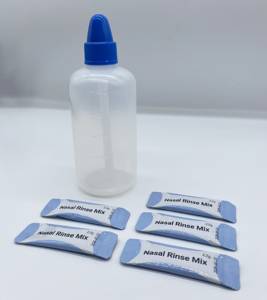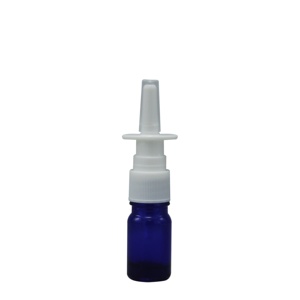
All categories
Featured selections
Trade Assurance
Buyer Central
Help Center
Get the app
Become a supplier

(1014 products available)














































Though both are used in nasal irrigation, the key difference is how the solution is delivered. A nasal squeeze bottle uses gentle pressure from squeezing the bottle to expel the saline solution from the nozzle into the nasal passages. This offers better control over the flow rate and is ideal for users who need a steadier, more directed irrigation stream.
In contrast, a saline nasal spray bottle relies on atmospheric pressure and is designed to mist or spray a fine, light droplets rather than a steady stream. This is primarily intended for nasal moisturization or medication delivery rather than deep cleansing. The spray may not reach as far into the nasal passages and therefore isn't as effective for flush or clearing congestion, but it's far more gentle and is usually better tolerated, especially in those with delicate nasal lining or moderate to severe bleeding or irritation.
Nasal bulb syringes are primarily used forclearing mucus from a newborn's nose. They are not strictly nasal squeeze bottles, but they work on the same principle of gentle squeezing to remove nasal congestion. These bulb syringes are primarily used in pediatric medicine to clear mucus from an infant's nose. They are simple, easy-to-use tools that consist of a soft, squeezable rubber bulb that expels air and then re-fills with mucus when released.
These bottles are commonly used in professional settings, particularly in medical fields, where precise control of fluid delivery is required. Unlike manual squeeze bottles, which rely on hand pressure to expel fluid, hydraulic squeeze bottles use a hydraulic system to provide a consistent and controlled flow of fluid. This is particularly important in surgeries or other medical procedures where precision is essential.
These bottles are used in various contexts, including food service, manufacturing, and medical fields for irrigation or cleansing purposes. In food service, for example, manual squeeze bottles are often used to dispense condiments, sauces, or other liquids in controlled amounts. Similarly, in medical settings, these bottles can be used for irrigation, administering medication, or cleansing wounds.
Bottle material
Nasal squeeze bottles are typically made from lightweight, durable plastic such as high-density polyethylene (HDPE) or polypropylene (PP). These materials were chosen for flexibility, strength, and resistance to chemical degradation. When selecting a saline nasal spray bottle, consider one made from these materials to ensure durability and resistance to chemical degradation. These bottles are also light in weight hence portable.
Cap and nozzle system
A cap with a built-in nasal nozzle or an adjustable nozzle is another prominent feature of these bottles. This allows for varied flow rates and stream strengths, depending on the user's needs for nasal irrigation. The adjustable nozzle also helps in directing the saline solution into the nasal passages effectively. Look for bottles with a cap that has a comfortable, easy-to-open design.
Bottle shape and ergonomics
Many squeeze bottles have contoured shapes to fit comfortably in the hand. This ergonomic design is aimed at providing a firm grip, even when wet. Having an ergonomic design also produces a steady, targeted stream of saline solution rather than a mist, which is more effective for deep nasal irrigation.
Measuring system
Some nasal squeeze bottles come with built-in measurement markings on the inner walls of the containers. This makes it easier to measure the saline solution and mix it with distilled or purified water as recommended for optimal nasal health. These measuring systems help to make every user a pro by showing exact indispensable quantities and eliminating guesswork.
Quality ergonomic squeeze bottles often contain features that provide comfort and convenience: the ergonomics of the bottle's shape, such as a rubber grip and lightweight materials, make it easy to hold even when one's hands get sweaty. A locking nozzle is also a good idea for those who don't want accidental spraying. To create durable squeeze bottles, use food-grade safe plastics like LDPE or PETG because they don't break easily and will keep drinks fresh for longer. They should be dishwasher safe. To make it easier to contain the right amount of liquid, consider adding measurement gradations. The entire package can look more appealing by using vibrant colors or unique shapes. Offering customizable options such as logos, varying cap sizes, or multiple colors is also a possibility. Ensuring it is affordable whilst not compromising on either quality or functionality is a must.
Nasal squeeze bottles are used for nasal irrigation, typically filling them with a saline solution to cleanse and moisturize the nasal passages. This is particularly useful for patients with chronic sinus issues or post-operative care. Medical professionals may also use squeeze bottles during surgeries to irrigate nasal tissues. In these medical contexts, hydraulic squeeze bottles are often employed due to their precise flow control and sterility features.
These squeeze bottles are used to remove mucus from the baby's nose. Parents or caregivers can gently squeeze the bottle to help clear blockages and make breathing easier for the infant. In this scenario, the design of the bulb syringae is user-friendly, allowing parents to maintain nasal hygiene without distressing the baby.
ENT specialists also use nasal squeeze bottles to assist in various diagnostic and therapeutic procedures. For example, during a consultation, an ENT doctor may use a squeeze bottle filled with saline to flush out the ear, perform irrigation, or give medication. In these cases, bottles made from durable, easy-to-clean materials like polypropylene are preferred.
Newborn caregivers often use simple bulb syringes or manual squeeze bottles to administer nasal drops or medications. In this scenario, the focus is on ease of use, safety, and affordability. Low-cost plastic squeeze bottles are commonly employed here for their disposable nature, which is hygienic for one-time use. These squeeze bottles are more accessible for parents who find it challenging to manage their newborn's nasal care. Therefore, these environments prioritize features like lightweight design, straightforward instructions, and low-cost options.
Hydraulic squeeze bottle
They require the most complex yet thorough cleaning among nasal squeeze bottles. One should always clean them after each use by using a soft detergent and warm water to clean the outside and inside of the bottle. Sterilizing should be done at least once a week. Maintenance of the hydraulic squeeze bottle generally consists of checking the hydraulic system for leaks or damage and ensuring all parts are securely attached and functioning. This means regular replacement may be required for any worn-out seals or parts to ensure proper functioning.
Manual squeeze bottles
One should clean these bottles after each use with warm water and mild detergent. These should also be rinsed thoroughly to remove any detergent residues. Bleach or vinegar may be used periodically to disinfect. Maintenance mainly involves checking for any cracks or leaks in the plastic. Inspect the nozzle for clogs and ensure it is cleaned properly after each use.
Bulb syringes
Bulb syringes should be rinsed in warm, soapy water immediately after each use. The bulb should then be squeezed and pulled apart to ensure the inside is clean. Sterilizing using boiling water or a steam sterilizer should be done regularly. Carefully inspect the bulb for any small holes or tears that may affect suction. Any older or worn-out rubber bulbs should be replaced.
Easy refilling and cleaning
This feature can be a game-changer as most refillable squeeze bottles come with wide mouths, making them easier to fill without making a mess. It is also important that the cleaning is made easy with bottles that are dishwasher-safe or come with cleaning brushes.
Leak-proof
Squeeze bottles by design should be leak-proof. However, some bottles do feature better leak-proof designs than others. It is wise checking reviews of the product to see if leaks have occurred when users have squeezed the bottles.
Durability and material-wise
Not all squeeze bottles last. Some only last because they are made of sturdy plastics such as HDPE and PET. These plastics are also resistant to chemical damage from sloshes of corrosive liquids and work great for creating transparent water bottles. It would be wise checking for warranty coverage that extends to several months.
Comfort and Control
To add comfort and control during usage, there are ergonomic squeeze bottles designed with special grips to give a comfortable hold and lessen wrist strain. This is especially ideal for individuals requiring frequent hydration.
Custom Cap/Nozzle Options
In cases where one would want to add condiments without the fuss or ready-made dressings, there are squeeze bottles that enable switching between nozzles or caps of differing sizes. This is targetting customization but rather versatility; for individuals requiring various flow rates or different liquids, such these options would be ideal.
A1: While both tools are used for nasal care, there is a key difference in design and application. Bulb syringas are primarily used in pediatric care to gently remove mucus from an infant's nose. On the other hand, nasal squeeze bottles, often seen in medical settings, are used for saline nasal irrigation in adults. They offer more control and are usually made from durable plastics specifically designed for nasal irrigation. While both serve essential functions in nasal care, the choice between them depends on the user's needs.
A2: It is very important because the material significantly affects the bottle's durability, flexibility, and ease of cleaning. For instance, bottles made from high-density polyethylene (HDPE) are incredibly tough yet lightweight, making them easy to handle. On the other hand, polypropylene (PP) is highly resistant to chemical damage, making it ideal for holding saline solutions. Additionally, the choice of material can impact the user experience; lighter materials like LDPE are more comfortable to hold, whereas sturdier plastics like PP offer greater control.
A3: Measuring indicators are very useful for precise filling and proper proportions. The presence of these indicators also means no more guesswork has to be filled, allowing mixtures to be prepared accurately for enhanced effectiveness, particularly for tasks like saline irrigation. In addition, these indicators save time as they eliminate the need for separate measuring tools, which can be cumbersome to clean after use. Overall, having built-in measuring indicators simplifies the process and ensures one never runs short or overfills during necessities.
A4: The most important one can do is to ensure regular maintenance and cleaning after each use, followed by proper storage away from direct sunlight. Selecting a quality squeeze bottle manufactured from robust materials such as LDPE or PETG plastic, which are bend-proof and do not shatter easily. Another important practice that should be adopted includes using only cool liquids inside the bottle. Cool liquids under normal temperature conditions, as opposed to hot liquids, will help maintain the shape of the bottle, including its mechanisms and functionality. This is also inclusive of preservation through regular replacement of worn-out seals or parts.